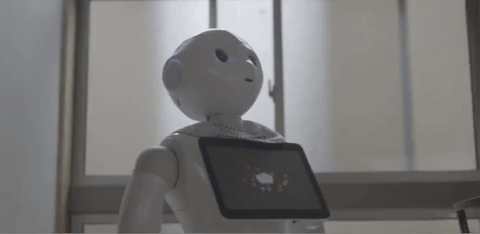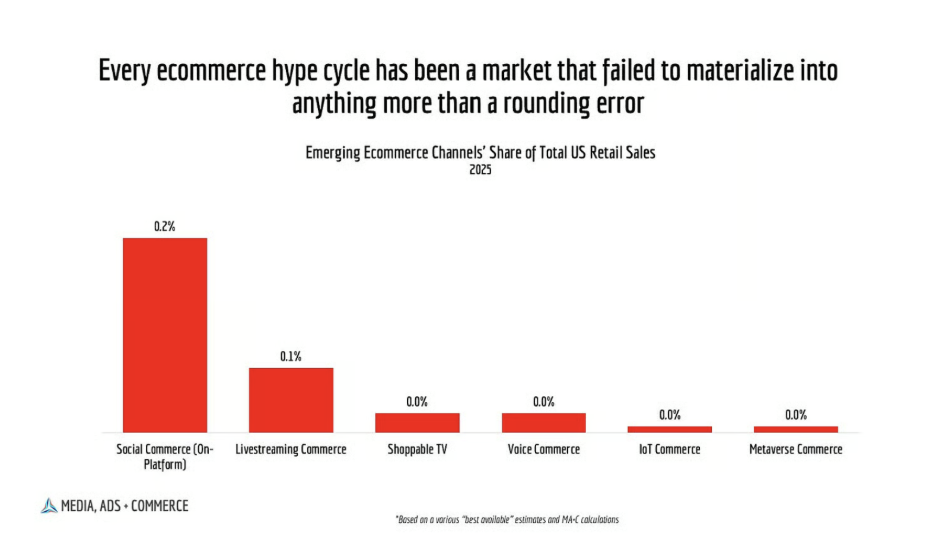

All revolutionary tech sounds amazing at the beginning. But you know how it ends, right?
We are told that AI’s gonna change everything. Possibly likely, yes. But after 30 years of “innovation,” with Google and Meta building the most powerful systems in history, how many businesses do you know that still don’t struggle to acquire new customers?
It always sounds harmless at first. Like a free upgrade. A faster path to the customer. But what looks like convenience usually comes at a cost.
The influencers and tech giants selling you the revolution? They’ll gain visibility, data, and control. But we’ll lose them, piece by piece - traffic, margins, and ownership.
ChatGPT’s Instant Checkout too sounds revolutionary. But then again, so did every interface that promised to change shopping forever. It’s a bold statement- but it simply wouldn’t work.

Alexa was supposed to make voice commerce the future. The Metaverse was meant to turn us all into virtual consumers.
Each time, the story starts the same: a breakthrough that will make life effortless.
Each time, it ends the same: the marketplace is a little less open, the merchant’s a little more dependent, and a consumer funneled through one more layer of mediation.
It’s not about being cynical, it’s about discounting hype that’s not backed by real world evidence.
Because most of these “innovations” never solved the real problems. They just solved for attention, ownership, and control.
And now, the big brand partnerships with OpenAI are promising the same thing, another ‘revolution’ that may look like progress, but feels a lot like déjà vu.
This week, Walmart announced a partnership with OpenAI that allows shoppers to buy directly inside ChatGPT. Last week it was Shopify that did the same.
This is the ideal expectation- you ask ChatGPT to “build a grocery list under $40” or “find the best washing machine under $500,” and it will surface Walmart products, process the transaction through Stripe’s Instant Checkout, and complete the purchase all within one conversation.

No website. No cart. No product page. Just a prompt, a product, and a purchase.
Together, these launches signal a bigger bet, that the future of shopping won’t start with a search bar or a store visit. It’ll start with a chat.
But the real question isn’t how fast they moved; it’s why they’re doing it. Because let’s be honest, this isn’t about fixing real merchant problems. It’s about staying visible in the biggest hype cycle of the decade.
If there’s one thing the tech world never runs out of, it’s FOMO.
“It's better to try and fail than to have never tried at all,” they say, conveniently ignoring that most businesses don’t have the luxury to fail publicly and write it off as R&D.
“It's quite possible there’s an AI bubble,” Mark Zuckerberg recently acknowledged. But also said he'd rather risk "misspending a couple of hundred billion" than miss superintelligence.
In other words: it’s better to overinvest and lose than risk being left out of the story. But like most merchants, I don’t think you have a spare couple of millions, forget couple hundred billions.
That’s the real fuel behind these AI rollouts, not customer demand or merchant pain points, but PR momentum & bubble-like funding.
Because right now, AI sells headlines faster than it sells products.
But for most businesses, the equation looks different. We’re working with limited resources, smaller teams, tighter budgets, and far less room for trial and error.
Yes, these announcements are shaping headlines today, but adoption always takes time, and attention doesn’t always translate into traction.
History offers a clear answer.
Every supposed retail “revolution,” AI or otherwise, has failed to transform behavior the way its creators imagined.

Just a few months ago it was- llms.txt a proposed “web standard” that lets websites tell large language models how to use their content.
It was pitched as a way to restore control to publishers and merchants, but it really just redefines compliance in a different dialect. Similar to sitemap, but it hasn’t delivered results.
Let’s take a step further from the headlines for a second. What happens after the excitement fades?
First, you lose control.
Your storefront, your data, your visibility, all start living inside someone else’s ecosystem. When checkout happens inside ChatGPT, you no longer decide how your products are displayed or discovered. You’re still the merchant of record, yes, you fulfill, you support, you deliver. But the path to you is no longer yours.
Then comes the distance.
Your customer still pays you, but they experience the platform. It’s ChatGPT that surfaces the product, ChatGPT that closes the sale, and ChatGPT that owns the final impression.
It’s like having a salesman who technically sells your product, but never tells you how he did it, what kind of promises he made, or even who he sold it to. Would you really rely on someone like that to run your business? You can follow up later, sure, but by then the emotional moment, that spark of trust when someone hits “buy”, belongs to someone else’s interface.
And eventually, you lose focus.
You start optimizing for the platform, tweaking prompts, updating feeds, chasing new integrations, instead of improving what actually converts in your store. It’s like a black box that might fancy you today, but you’ll never know when it decides to change the rules.
Your roadmap starts aligning with their product updates instead of your growth priorities. It’s a never-ending cycle: platforms capture the customer’s attention; merchants adjust around it.
Now let’s switch sides.
Even for shoppers, this new setup doesn’t really add up.
A chatbot that already feels a little too confident, sometimes even manipulative, is now expected to guide purchase decisions. It’s the same voice that argues about facts one moment and recommends products the next.
Would you really share your address, contact details, and payment info inside a chat window that doesn’t even belong to a brand, especially one known to hallucinate answers, twist context, or cheat, manipulate what you see?
And buying isn’t just about speed. It’s about the whole experience.
Shoppers still want to compare, scroll, zoom in, read reviews, maybe even get lost a little before committing.
That very journey, the visual, emotional, messy part of shopping, disappears when the interface becomes just text and buttons.
We live in a hype culture. Every week, there’s a new “paradigm shift.” A new demo video. A new promise that this time, it’s different.
ChatGPT was supposed to “replace Google.”
GPTs were marketed as the “end of websites.”
And now, Instant Checkout will apparently change the way the world shops.
Take traffic for example. Ahrefs studied more than 35,000 websites and found that AI chatbots send just 0.1 % of all referral traffic. Not 10 %. Not 1 %. A tenth of a percent. For context, that’s less than what most brands still get from email newsletters.
The product might be new. The pattern isn’t.
Hype peaks first, behavior never follows, and a few months later, we move on like it never existed. When was the last time you actually bought something using Alexa? Or walked through a Metaverse store to check out?
Because for all the talk about “revolutionizing the internet,” AI still hasn’t solved the simplest problem in commerce, getting people to click, trust, and buy.
Sure, it’s convenient. But would you really buy or gift a $1,000 product through ChatGPT?
Open ChatGPT and search for something real say, “3-seater sofa under $1,000.”
Here’s what you’ll find: about 10 products, mostly from Walmart, Wayfair, and Etsy. No filters, no reviews, no ratings, no user photos.

Just product names, prices, and a “Buy” button.
There’s no sense of why one sofa is better than another; no proof that anyone actually bought or liked it. You can’t zoom in, check the fabric texture, or scroll through customer photos.
In other words, it’s everything ecommerce spent the last decade trying to fix- trust, proof, and context, all stripped away in the name of convenience.
Because the buying journey isn’t just about finding something, it’s about believing it’s the right thing, having an emotional connection to it.
And a chatbot showing a handful of generic listings doesn’t build belief. It builds hesitation.
Do you really think a logical tool like ChatGPT could have caused or even predicted the Labubu trend?
In 2024, Chinese toy maker Pop Mart, expected reach $4.2 billion in 2025 as the Labubu craze continues to grow.
That’s not data-driven growth; that’s one-sided emotion-driven demand.
What prompt could have predicted that?
AI can analyze trends, summarize insights, and automate checkouts. But it can’t predict the spark that makes people line up for a $15 collectible or turn it into a billion-dollar phenomenon.
Because e-commerce has never just been about convenience. It’s about belonging, emotion, and that unquantifiable moment when something simply clicks.